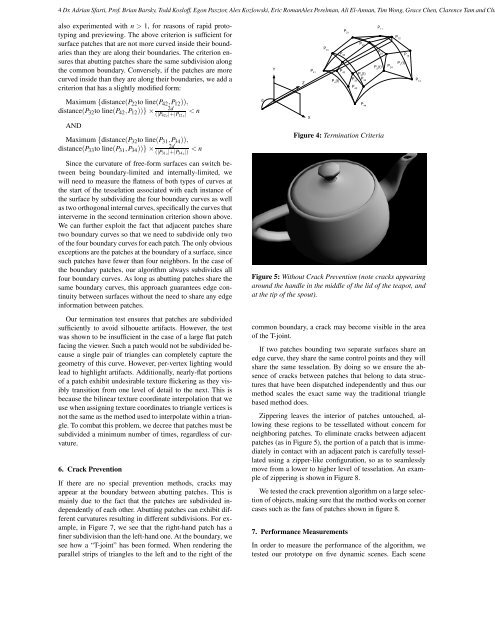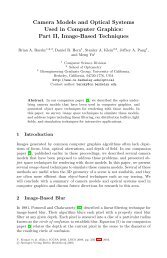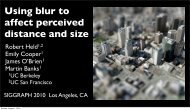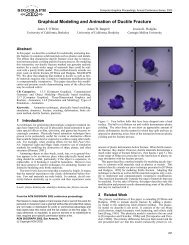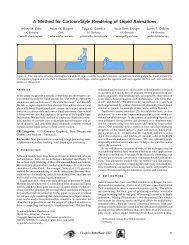Download Paper - Computer Graphics - University of California ...
Download Paper - Computer Graphics - University of California ...
Download Paper - Computer Graphics - University of California ...
You also want an ePaper? Increase the reach of your titles
YUMPU automatically turns print PDFs into web optimized ePapers that Google loves.
4 Dr. Adrian Sfarti, Pr<strong>of</strong>. Brian Barsky, Todd Kosl<strong>of</strong>f, Egon Pasztor, Alex Kozlowski, Eric RomanAlex Perelman, Ali El-Annan, Tim Wong, Grace Chen, Clarence Tam and Chr<br />
also experimented with n > 1, for reasons <strong>of</strong> rapid prototyping<br />
and previewing. The above criterion is sufficient for<br />
surface patches that are not more curved inside their boundaries<br />
than they are along their boundaries. The criterion ensures<br />
that abutting patches share the same subdivision along<br />
the common boundary. Conversely, if the patches are more<br />
curved inside than they are along their boundaries, we add a<br />
criterion that has a slightly modified form:<br />
Y<br />
Z<br />
P 21<br />
P 2 (t)<br />
P 1 (t)<br />
P 32<br />
P 3 (t)<br />
P 4 (t)<br />
P 33<br />
P 34<br />
P 12<br />
P 41 P 42<br />
P 43<br />
P 44<br />
Maximum {distance(P 22 to line(P 42 ,P 12 )),<br />
2d<br />
distance(P 32 to line(P 42 ,P 12 ))} × (|P 42z |+|P 12z | < n<br />
AND<br />
Maximum {distance(P 32 to line(P 31 ,P 34 )),<br />
2d<br />
distance(P 33 to line(P 31 ,P 34 ))} × (|P 31z |+|P 34z |) < n<br />
Since the curvature <strong>of</strong> free-form surfaces can switch between<br />
being boundary-limited and internally-limited, we<br />
will need to measure the flatness <strong>of</strong> both types <strong>of</strong> curves at<br />
the start <strong>of</strong> the tesselation associated with each instance <strong>of</strong><br />
the surface by subdividing the four boundary curves as well<br />
as two orthogonal internal curves, specifically the curves that<br />
interverne in the second termination criterion shown above.<br />
We can further exploit the fact that adjacent patches share<br />
two boundary curves so that we need to subdivide only two<br />
<strong>of</strong> the four boundary curves for each patch. The only obvious<br />
exceptions are the patches at the boundary <strong>of</strong> a surface, since<br />
such patches have fewer than four neighbors. In the case <strong>of</strong><br />
the boundary patches, our algorithm always subdivides all<br />
four boundary curves. As long as abutting patches share the<br />
same boundary curves, this approach guarantees edge continuity<br />
between surfaces without the need to share any edge<br />
information between patches.<br />
Our termination test ensures that patches are subdivided<br />
sufficiently to avoid silhouette artifacts. However, the test<br />
was shown to be insufficient in the case <strong>of</strong> a large flat patch<br />
facing the viewer. Such a patch would not be subdivided because<br />
a single pair <strong>of</strong> triangles can completely capture the<br />
geometry <strong>of</strong> this curve. However, per-vertex lighting would<br />
lead to highlight artifacts. Additionally, nearly-flat portions<br />
<strong>of</strong> a patch exhibit undesirable texture flickering as they visibly<br />
transition from one level <strong>of</strong> detail to the next. This is<br />
because the bilinear texture coordinate interpolation that we<br />
use when assigning texture coordinates to triangle vertices is<br />
not the same as the method used to interpolate within a triangle.<br />
To combat this problem, we decree that patches must be<br />
subdivided a minimum number <strong>of</strong> times, regardless <strong>of</strong> curvature.<br />
6. Crack Prevention<br />
If there are no special prevention methods, cracks may<br />
appear at the boundary between abutting patches. This is<br />
mainly due to the fact that the patches are subdivided independently<br />
<strong>of</strong> each other. Abutting patches can exhibit different<br />
curvatures resulting in different subdivisions. For example,<br />
in Figure 7, we see that the right-hand patch has a<br />
finer subdivision than the left-hand one. At the boundary, we<br />
see how a “T-joint” has been formed. When rendering the<br />
parallel strips <strong>of</strong> triangles to the left and to the right <strong>of</strong> the<br />
d<br />
X<br />
Figure 4: Termination Criteria<br />
Figure 5: Without Crack Prevention (note cracks appearing<br />
around the handle in the middle <strong>of</strong> the lid <strong>of</strong> the teapot, and<br />
at the tip <strong>of</strong> the spout).<br />
common boundary, a crack may become visible in the area<br />
<strong>of</strong> the T-joint.<br />
If two patches bounding two separate surfaces share an<br />
edge curve, they share the same control points and they will<br />
share the same tesselation. By doing so we ensure the absence<br />
<strong>of</strong> cracks between patches that belong to data structures<br />
that have been dispatched independently and thus our<br />
method scales the exact same way the traditional triangle<br />
based method does.<br />
Zippering leaves the interior <strong>of</strong> patches untouched, allowing<br />
these regions to be tessellated without concern for<br />
neighboring patches. To eliminate cracks between adjacent<br />
patches (as in Figure 5), the portion <strong>of</strong> a patch that is immediately<br />
in contact with an adjacent patch is carefully tessellated<br />
using a zipper-like configuration, so as to seamlessly<br />
move from a lower to higher level <strong>of</strong> tesselation. An example<br />
<strong>of</strong> zippering is shown in Figure 8.<br />
We tested the crack prevention algorithm on a large selection<br />
<strong>of</strong> objects, making sure that the method works on corner<br />
cases such as the fans <strong>of</strong> patches shown in figure 8.<br />
7. Performance Measurements<br />
In order to measure the performance <strong>of</strong> the algorithm, we<br />
tested our prototype on five dynamic scenes. Each scene


